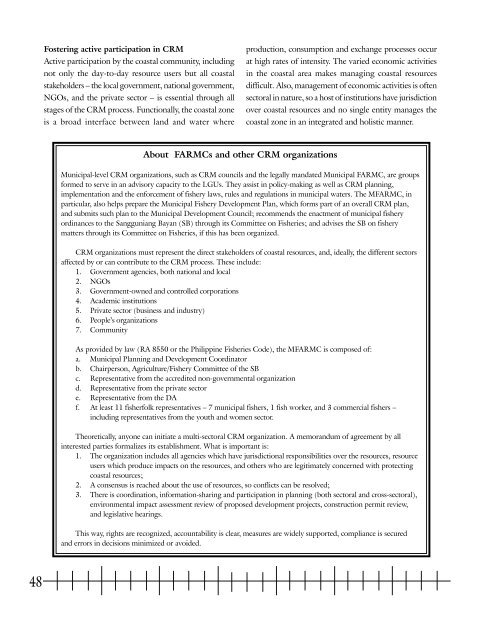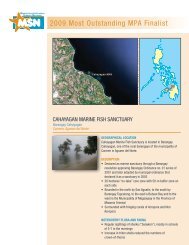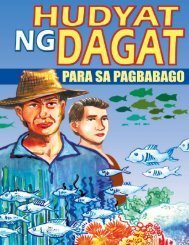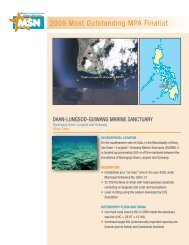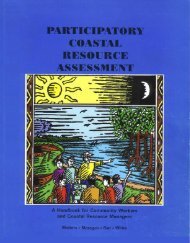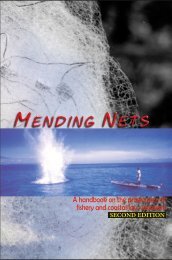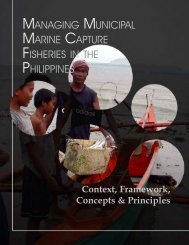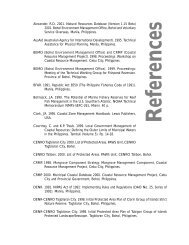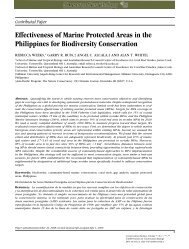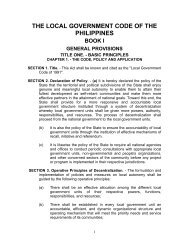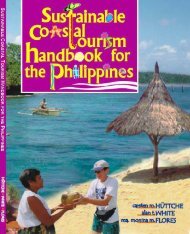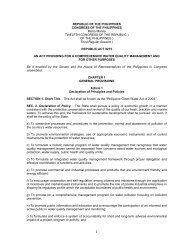Part 2 - Oneocean.org
Part 2 - Oneocean.org
Part 2 - Oneocean.org
- No tags were found...
Create successful ePaper yourself
Turn your PDF publications into a flip-book with our unique Google optimized e-Paper software.
Fostering active participation in CRMActive participation by the coastal community, includingnot only the day-to-day resource users but all coastalstakeholders – the local government, national government,NGOs, and the private sector – is essential through allstages of the CRM process. Functionally, the coastal zoneis a broad interface between land and water whereproduction, consumption and exchange processes occurat high rates of intensity. The varied economic activitiesin the coastal area makes managing coastal resourcesdifficult. Also, management of economic activities is oftensectoral in nature, so a host of institutions have jurisdictionover coastal resources and no single entity manages thecoastal zone in an integrated and holistic manner.About FARMCs and other CRM <strong>org</strong>anizationsMunicipal-level CRM <strong>org</strong>anizations, such as CRM councils and the legally mandated Municipal FARMC, are groupsformed to serve in an advisory capacity to the LGUs. They assist in policy-making as well as CRM planning,implementation and the enforcement of fishery laws, rules and regulations in municipal waters. The MFARMC, inparticular, also helps prepare the Municipal Fishery Development Plan, which forms part of an overall CRM plan,and submits such plan to the Municipal Development Council; recommends the enactment of municipal fisheryordinances to the Sangguniang Bayan (SB) through its Committee on Fisheries; and advises the SB on fisherymatters through its Committee on Fisheries, if this has been <strong>org</strong>anized.CRM <strong>org</strong>anizations must represent the direct stakeholders of coastal resources, and, ideally, the different sectorsaffected by or can contribute to the CRM process. These include:1. Government agencies, both national and local2. NGOs3. Government-owned and controlled corporations4. Academic institutions5. Private sector (business and industry)6. People’s <strong>org</strong>anizations7. CommunityAs provided by law (RA 8550 or the Philippine Fisheries Code), the MFARMC is composed of:a. Municipal Planning and Development Coordinatorb. Chairperson, Agriculture/Fishery Committee of the SBc. Representative from the accredited non-governmental <strong>org</strong>anizationd. Representative from the private sectore. Representative from the DAf. At least 11 fisherfolk representatives – 7 municipal fishers, 1 fish worker, and 3 commercial fishers –including representatives from the youth and women sector.Theoretically, anyone can initiate a multi-sectoral CRM <strong>org</strong>anization. A memorandum of agreement by allinterested parties formalizes its establishment. What is important is:1. The <strong>org</strong>anization includes all agencies which have jurisdictional responsibilities over the resources, resourceusers which produce impacts on the resources, and others who are legitimately concerned with protectingcoastal resources;2. A consensus is reached about the use of resources, so conflicts can be resolved;3. There is coordination, information-sharing and participation in planning (both sectoral and cross-sectoral),environmental impact assessment review of proposed development projects, construction permit review,and legislative hearings.This way, rights are recognized, accountability is clear, measures are widely supported, compliance is securedand errors in decisions minimized or avoided.48


